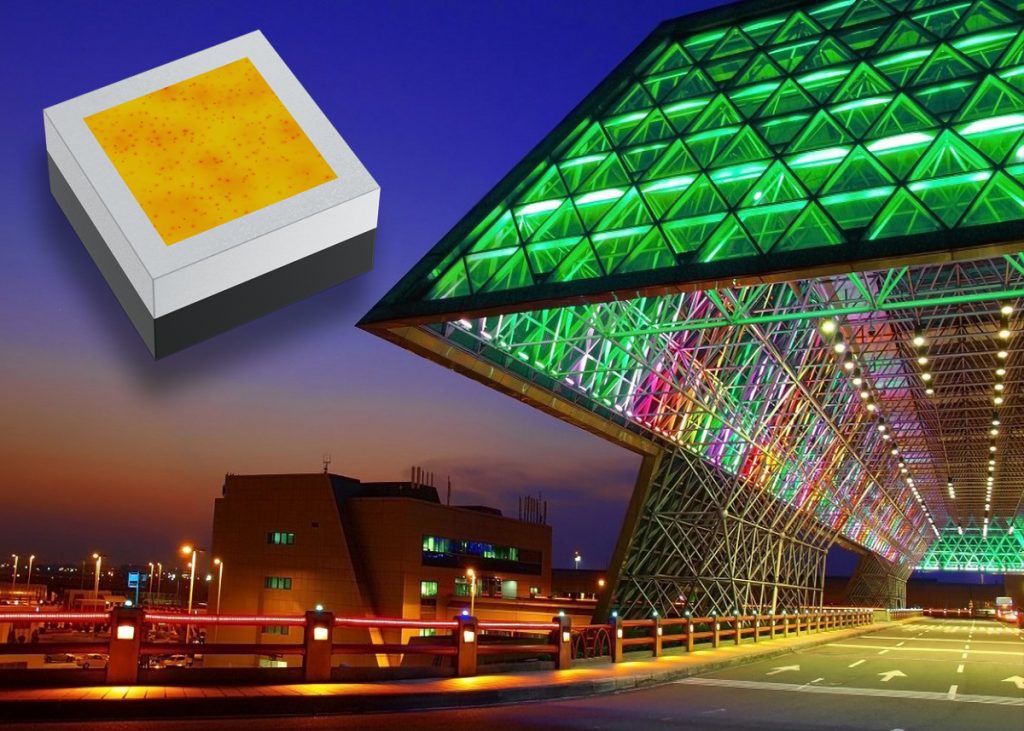High-brightness LEDs with tiny footprint now available in white and saturated colors
Multiple Lumileds LUXEON Rubix white and color LEDs can be mounted close together under a single optic to enable excellent color mixing at source and a bright light output from a small light-emitting surface.

Lumileds has extended its range of small, high-power LUXEON Rubix LEDs, adding bright white emitters in various color temperatures to its existing color lines. Sharing a common footprint, the LUXEON Rubix LEDs give luminaire manufacturers a simple way to build flexible product designs that can produce a white output or saturated colors.
The white LUXEON Rubix LEDs are now available in 6,500 K, 5,000 K, 4,500 K, 4,000 K, 3,500 K, 3,000 K, 2,700 K and 2,200 K color temperatures at minimum 80 CRI, 6,500 K at 70 CRI, and 2,700K at 90 CRI. The existing LUXEON Rubix LED colors are Red, phosphor-converted (PC) Amber, Lime, Green, Cyan, Blue and Royal Blue. The LUXEON Rubix family already included a 5,700 K white with a minimum 60 CRI.
The announcement is significant for architectural and entertainment lighting because the LUXEON Rubix LEDs are so well adapted for color mixing. Featuring a common 1.4 mm x 1.4 mm footprint, different colors and white can easily be mixed in different luminaires that share the same board layout and electrical circuit design. The only exception is the Red LED, which has a 1.4 mm x 1.8 mm footprint.
The small size of LUXEON Rubix LEDs enables reduced spacing under a single optic, which results in better optical mixing. This allows lighting designers to work with a broad palette of mixed colors, and to create novel and exciting lighting effects. Thanks to these compact LEDs, architectural lighting schemes can now emulate the dynamism and color-rich effects seen in entertainment lighting.
The LUXEON Rubix LEDs offer an unusually high current capability in such a small package, which means that they can produce very bright light from a small area, for high lumen density. This is valuable in applications such as theatrical lighting that have to throw light long distances. The small footprint and light-emitting surface of these LEDs also makes it easy to couple their light into a small optic with a beam angle as narrow as 10°.
The white LEDs can handle a maximum drive current of 1.6 A. For the color LEDs, maximum current is 3 A, except Red, which is 2.4 A.
|
Color |
Dominant or Peak Wavelength (nm) | Luminous Flux (lm) or Radiometric Power (mW) | ||
| Minimum | Maximum | Minimum | Typical | |
| Red | 620 | 630 | 75 | 85 |
| PC Amber | – | – | 220 | 250 |
| Lime | – | – | 420 | 510 |
| Green | 520 | 535 | 260 | 310 |
| Cyan | 490 | 510 | 180 | 230 |
| Blue | 465 | 485 | 70 | 112 |
| Royal Blue | 440 | 455 | 1,300 | 1,635 |
| Color | Nominal CCT | Minimum CRI | Luminous Flux (lm) | Typical Luminous Efficacy (lm/W) | |
| Minimum | Typical | ||||
| White | 5,700 K | 60 | 360 | 440 | 93 |
| Color | Nominal CCT | Minimum CRI | Luminous Flux (lm) | Typical Luminous Efficacy (lm/W) | |
| Minimum | Typical | ||||
| White | 6,500 K | 70 | 220 | 315 | 106 |
| 2,200 K | 80 | 140 | 208 | 70 | |
| 3,000 K | 80 | 200 | 263 | 89 | |
| 4,000 K | 80 | 200 | 274 | 93 | |
| 6,500 K | 80 | 220 | 280 | 95 | |
| 2,700 K | 90 | 140 | 205 | 69 | |
